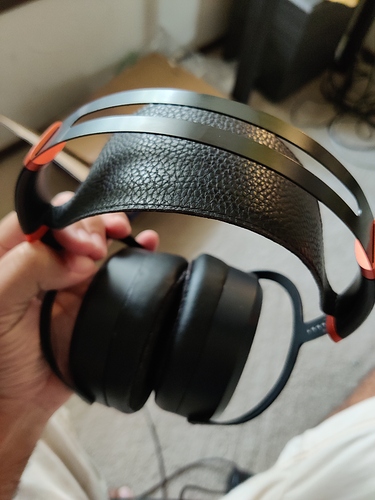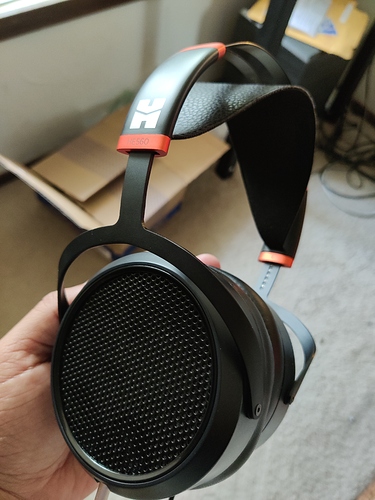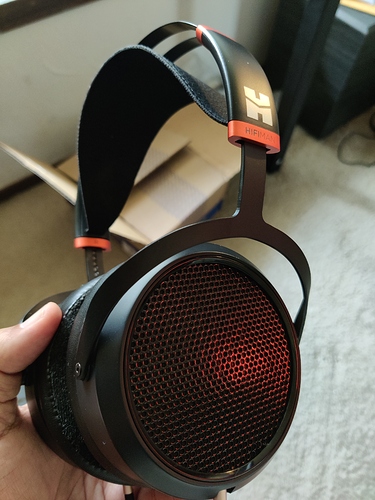INTRODUCTION
I’ve had the HE4XX for about 8 or 9 months now. It’s a very good headphone for its price. It’s also a solid introduction to planar-magnetic drivers. So, here is a review. As with my Senn HD6XX review, I have tried to make this review “scale-able” by making it clear what parts are targeted to newer audiophiles and readers who haven’t read my other reviews on this forum and which parts are more useful for more veteran audiophiles. Alright, let’s get to it.
KNOW YOUR REVIEWER (skip this if you’ve read lots of my posts on this forum)
My preferred genres are rock/metal and classical/orchestral music. I’m getting to know jazz more and enjoying quite a bit. I also listen to some EDM and hip-hop. My hearing quirks include a high sensitivity to midrange frequencies from just under 1KHz to around 3Khz, give or take. My ears are thus quick to perceive “shoutiness” in headphones in particular. I describe “shoutiness” as an emphasis on the ‘ou’ sound of ‘shout.’ It’s a forwardness in the neighborhood of 1KHz and/or on the first one or two harmonics above it (when I make the sound ‘ooooowwwww’ into a spectrum analyzer the dominant frequency on the vowel sound is around 930Hz, which also means harmonic spikes occur again at around 1860Hz and 2790Hz). In the extreme, it can have the tonal effect of sounding like a vocalist is speaking or singing through a toilet paper tube or cupping their hands over their mouth. It can also give instruments like piano, but especially brass instruments, an added ‘honk’ to their sound. I also get distracted by sibilance, or sharp ‘s’ and ‘t’ sounds that can make ssssingers sssssound like their forssssssing esssss ssssssounds aggresssssssively. Sibilance does not physically hurt my ears nearly as quickly as shout, though. It’s distracting because it’s annoying and unnatural. Readers should keep these hearing quirks in mind as they read my descriptions of sound.
Prior to owning the 4XX I had the V-Moda Crossfade M-100, Beyerdynamic DT990-32ohm, Monolith M1060, Massdrop – Sennheiser HD6XX, and Dekoni Blue. After the 4XX I’ve also acquired Ikko OH-10, Tin T3, Beyerdynamic DT880-600ohm, HiFiMan Edition XX, and Fostex TH-X00 Purpleheart. I’ve also used the 4XX on combinations of the following amps, dacs, and amp-dacs: Schiit Magni 3, JDS Labs Atom, Monolith Liquid Spark, Loxjie P20, SMSL SP200, Darkvoice 336SE, Schiit Asgard 3, Schiit Modi 3, Topping D10, SMSL M100, SMSL SU-8, Fiio E18, Topping NX4-DSD, iFi Hip-Dac. I’ve even used a Nobsound/Doak Audio tube buffer in the signal chain with 4XX as well.
HE4XX INFO (for beginners)
The HE4XX is a collaboration between (Mass)Drop and HiFiMan. It is a Massdrop branded and distributed version of one of the HiFiMan HE400 series headphones, but I don’t remember which one. It uses planar-magnetic drivers. It is rated at 35 ohms of impedance but with 93 dB/mW sensitivity. The first number suggests it’s easy to drive. The second number suggests an amplifier is recommended to get the most out of them. Innerfidelity measures its impedance at 49 ohms at 1KHz.
BUILD (if you’re familiar with 4XX build, move along, nothing new here)
The 4XX is quite comfortable to wear for extended periods. It also comes across as decently built for the price. If you Google them, they do at times have longevity issues. Some of the HiFiMan quality control issues are mitigated by Massdrop’s involvement, but not all. The cable is detachable with each earcup having a 3.5mm input. The included cable has a 3.5mm connector with a 6.3mm adapter. The earcup connections are 3.5mm TRS plugs but are only wired with the tip (+) and shaft (-) active. My unit had a loose 3.5mm jack in the left cup. The nut that clamps down to hold it tight came a bit loose, but I was able to tighten it down just fine. I haven’t had issues since that tightening.
SOUND
Signature:
To my ear the 4XX sounds like it has a slight W shaped sound signature but with a significant bass roll-off below about 80Hz. It sounded like the bass from around 80-200Hz had a slight elevation. Then it sounds like there is a dip from about 200Hz to around 400 Hz. There was a lesser-than-the-bass-sounding boost in the mids from there to about 1KHz, then another dip before the treble climbed back up again starting around 4 or 5 KHz and stays high up into the ‘air’ range around 10KHz. After listening for awhile and then looking up frequency response curves, like the one from Innerfidelity, I was genuinely shocked to see almost flat measured response from about 50Hz to 1KHz. The dip from just over 1KHz to about 4 KHz was there followed by a wider treble elevation from 5KHz to about 10KHz; an elevation which is only slightly higher than the flat region in the below 1KHz. But, that flat response – in this case meaning basically the same SPL everywhere in the range – from 50Hz to 1Khz really surprised me. To me it sounds like the sub-bass roll-off happens more aggressively around 80 Hz and that there was a dip in the upper-bass/lower-mid region. Either way, don’t expect super extended and powerful sub-bass. But the bass impact around 100Hz is pretty slamming. The treble can sound a bit forward if you’re coming from a headphone like the 6XX. The treble is sibilant initially to my ear, but my ears/brain compensate after a few minutes and I only notice sibilance if the recording is sibilant. The mids are mixed bag which I will discuss more in the Timbre section.
Detail Retrieval:
The level of detail retrieval is pretty solid for a headphone in this price range. It’s not class-leading in the <$200 market (DT880 600 ohm), but it’s not as relaxed sounding as the 6XX. “Lady in Black” by Uriah Heep is reverb-heavy on the drums, guitars, and vocals. The 4XX gives a hint of that “planar speed”, resolving that reverb pretty well. However, the reverb is louder on other headphones. The detail is there on the 4XX, but even Massdrop’s and HiFiMan’s own Edition XX plays that detail at a seemingly higher SPL. However, for the current price of $160, the level of detail seems quite appropriate as is neither lacking nor aggressive.
Spatial Performance:
The soundstage is decently wide. There are wider soundstages out there, but again for $160 it’s decently wide. The imaging is a mixed bag. The sonic image stretches from left to right fairly seamlessly without noticeable holes. But nor is the imaging sharp. The center image is noticeable but it’s not as center-locked as it could be. Instruments are placed horizontally well but they’re not separated particularly well. The sonic images blend into each other across the soundstage a bit. Again, though, it bears repeating that at $160 the spatial presentation is pretty solid.
Timbre:
I’ll come back to my comment about the midrange here. To my ear the oddest part of the timbre is in the upper-bass/lower-mids. It sounds to me like there is a reduction in the frequency response somewhere in the 200-400Hz range. This apparent dip makes things like vocals and drum hits sound a little hollow. This sound is not shouty. To me shouty sounds like frequencies added. This is more frequencies missing. Some of this is probably an amp pairing issue. Op-amp based amps likes the Atom and SP200 seemed to be the bigger culprits here. Warmer sounding amps like the Liquid Spark and Asgard 3 smoothed that out some, but it was still detectable on those amps. For example, as I type this I’m listening to the 4XX through the Asgard. “Cum on Feel the Noize” by Quiet Riot came on in my shuffle. The opening drums and vocal entry early in the song had a bit of that hollowness going on. It wasn’t severe, but it was noticeable and “I don’t know why. I don’t know why.” (couldn’t resist)
I’ll make a note on the treble here. To my ear the initial excess sibilance of the 4XX disappears after a few minutes of listening. But the treble can have a bit of a hashy timbre at times. Rapid cymbal hits can a bit shishishish-y, to be onomatopoeic. Much like the initial sibilance, though, that quality fades as listening goes on.
But If You Tube It:
In my 6XX review I mentioned the 4XX does not tube well. I should clarify that some here. The 4XX does not do well on an OTL tube amp like the Darkvoice. However, I did have good results with it on hybrid tube amps (Loxjie P20) and with a tube buffer. The P20 naturally provided even more warmth in that perceived frequency dip in the upper-bass/lower-mids and gave the 4XX a really full, rounded-out sound. I obtained similar results powering the 4XX off an Atom with the tube buffer stuck between the DAC and the Atom in the signal change. The buffer again added a boost in the perceived hole and provided a similarly rounded-out experience. The Asgard and the Liquid Spark came close to that tube result, but couldn’t quite get there.
WALKING THE DOG
A really nice experience was putting on the 4XX on a non-windy day (strong wind can damage an open-back planar), powering it with the iFi Hip-Dac, and going for a walk. The Hip-Dac has a lot of extra warmth for a solid-state amp and is a good sonic match for the 4XX. The XBASS on the Hip also extends the bass some and gives more rumble in the sub-bass. I imagine the iFi Zen, when used as a DAC, would provide similar results.
COMPARISON TO OTHER HEADPHONES
Two other popular open-back headphones in the ~$200 price range are the Beyerdynamic DT-880 and the Massdrop + Sennheiser HD6XX. I’ll use the 600 ohm DT-880 in this comparison. Signature-wise, the 6XX is neutral-warm, the 880 neutral-bright, and the 4XX more W-shaped (eh, it still sounds that way to me, anyway). In a number of areas – soundstage, imaging, bass and treble extension, detail retrieval – the 4XX is the middle of the three. In overall timbre quality, I would have to rank the 4XX third. However, for me the 4XX is the most enjoyable of the three for rock and metal. It’s timbre issues – although relatively minor in the scheme of things – are the least noticeable in most rock and metal music. The 4XX does have the punchiest bass in the 100Hz region of the three though; a plus for rock and metal. It also has enough treble extension to give it sparkle, but not overwhelm. However, for acoustic music like jazz and classical, the 4XX cannot compete with the DT880’s ability to create space and place and separate instruments, and cannot keep up with either the 880 or the 6XX in instrument timbre.
FINAL THOUGHTS
I like the 4XX. It’s a solid headphone, especially for rock, metal, hip-hop, and EDM. At $160 it’s a really good deal. It hints at the speed planar-magnetic drivers are capable of. It provides an overall very enjoyable experience. For a period of time, it was my go-to headphone for rock and metal. However, it is likely to be sold soon. That doesn’t mean I don’t think it’s worth the money and the experience – it is. I just have better options now and it no longer fills a unique role for me. Still, if you’re new to the headphone game and still in the mode of exploring budget audiophile headphones, the 4XX should absolutely be on your list.




